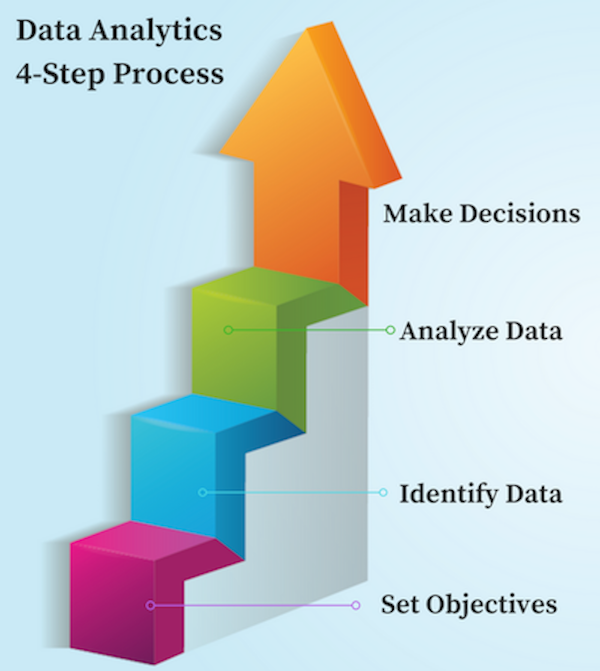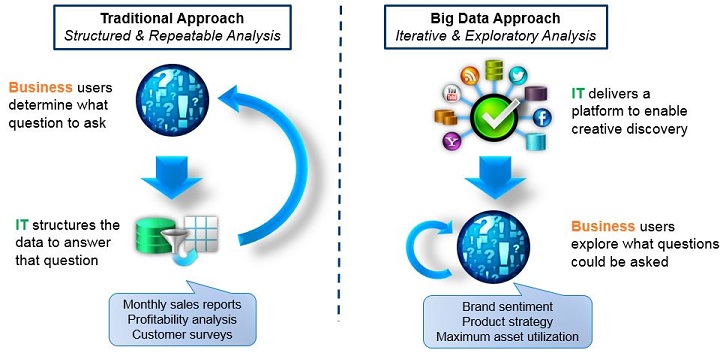Formula 1 races are not won by the size of the engine, the aerodynamics of the car or even the skill of the driver. The difference between winning and losing a race comes down to an unlikely racing tactic: data analytics.
Each car is equipped with over 150 sensors that track key performance stats in real time such as fuel efficiency, tire pressure, brake heat, GPS and wind speeds. Each sensor is a data source that is analyzed to help answer specific questions during the race that gives the team a competitive advantage.

For example, Formula 1 analysts can use the data to determine which laps the car should stop for a pit stop. Would it be faster to do a pit stop at lap 10 or lap 14? In a sport where seconds matter, the right answer can help the team win.
While the massive amount of data generated by the car is important, the analytics that translates the data into actionable insights is what delivers the value during the race.
Your business is just like a Formula 1 race car.
Okay, you might not be a global celebrity, popping champagne after each win, but similar to Formula 1, your business generates a lot of data that can be used to answer questions that give you a competitive advantage. Understanding how to leverage data analytics can make the difference between your company winning or losing the race.
The Difference Between Big Data and Data Analytics
Formula 1 cars transmit 2GB of data every lap and 3TB during a full race. When you consider there are 20 races per season, the cars are generating over 60 terabytes of data.
While that is a huge amount of data, the race-time decisions are not driven by the amount of data, but rather by questions that need answers. This is the fundamental difference between Big Data and Data Analytics.
- What is Big Data? It's defined as high-volume, high-velocity and/or high-variety information assets (data) that require innovative forms of information processing to collect, clean, store and use.
- What is Data Analytics? It's the process of examining data with a specific objective in mind to find answers that help you make evidence-backed business decisions.
The 60TB of data collected during a Formula 1 season is big data. It's a huge volume of data that consists of different types of data(variety), both structured and unstructured. Analysts and data scientists must process this type of data using powerful computing systems and then sift through it to discover trends or correlations that can help solve problems.
This type of exploratory big data analytics usually leads to new, macro-level efficiencies for your business. For example, the Formula 1 team might discover by analyzing their big data that they have slower lap times when they use a certain type of fuel. By changing the fuel, they might give themselves a better chance of winning.
Data analytics, on the other hand, is designed to help you answer questions around specific business objectives. In the same way a Formula 1 team wants to know which lap is best for a pit stop, data analytics helps you answer questions that help your business win.
Data analytics is the process of using data (facts) to solve problems. Whether you are manually analyzing the data or using an automated analytics application, such as Interana or DataHero, data analysis always starts with a question and then examines the data to find answers.
Data Analytics is Transforming Business
Believe it or not, your company creates just as much data as a Formula 1 team, if not more. Every operational task and customer interaction generates valuable data that you can analyze to make better decisions and uncover insights with the power to transform your business.
The companies that have embraced data analytics not only outperform their competitors, but they continually exceed expectations.
According to the report from McKinsey Global Institute, companies that use data analytics to make decisions across their business have a 23x greater likelihood of customer acquisition, a 6x greater likelihood of reducing customer churn, and a 19x greater likelihood of being profitable.
The benefits of using data analytics to drive decisions can impact every aspect of your business including operations, marketing, and product. But you don't have to take our word for it.
Transforming Operations
UPS put tracking sensors on over 10,000 delivery trucks in an effort to optimize their routes. Their analytics project started with a simple question: Can we reduce fuel consumption by finding faster routes for our drivers? They now save 10 million gallons of gas and eliminated 12.1 million miles of driving per year.
Transforming Customer Relationships
T-Mobile implemented analytics to reduce customer turnover rates. They matched social media data of their subscribers with their CRM software and internal billing to identify their loyal subscribers with high-lifetime-value to create a personalized retention campaign. They were able to reduce churn by 50%.
Transforming Products
Netflix uses data analytics to select what types of content they produce. By analyzing the behavioral data of what their viewers watch, they can develop content that will appeal to those behaviors. The result: Netflix sales are up 36% and they produced 5 of the top 10 shows people searched for in 2016.
The potential of your data goes beyond just making good decisions. You have the ability to find insights about your business or customers that can reshape your approach and lead to tremendous growth.
4 Steps to Start Analyzing Your Business Data
Don't be overwhelmed by the thought of implementing data analytics in your business. You are already generating a lot of data within your current systems and today's analytics tools have become accessible and easy to integrate.
Before you dive headfirst into your data, we've put together 4 steps to help you get started.

Step 1: Set clear objectives. Data analytics should always start with a business objective. Are you trying to reduce fuel costs like UPS or reduce customer churn like T-Mobile? Once you establish your goals, it will be much easier to figure out your questions and the data you will need to find answers.
Step 2: Identify the right data. When you know what you want to achieve, the next step is to find the best data and metrics within your technology applications. For example, if you want to track your customer experience across social and your site, you could use an identity management tool like Auth0 to collect your customers' social media data.
Step 3: Use a tool to analyze data. In the past, you needed a data analyst who was highly trained in statistics. Technology has changed the game, giving every business of every size the ability to get answers from their data. If you do not have an IT team to help you, there are several self-service analytics tools available, such as Interana, that are designed to use your data to answer your questions.
Step 4: Make the decision. Data analysis gives you the information necessary to make a decision or take an action, but it can't make the decisions for you — at least not yet. Your ability to interpret the data and act on the insights is what truly sets you apart from the competition.
To help you interpret your analysis, ask yourself these three questions:
- How does the conclusion answer the question?
- Does the data help defend against any objections? How?
- Can the insights be used to make tangible changes to the business?
Technology is making it possible for every business to collect and analyze data without the need for data scientists or even IT. At the end of the day, it is not your lack of data or analytics tools that will make the difference. It is your ability to set clear objectives, ask the right questions and act on the insights from the analysis.
Data Analytics is Worthless Without You
A lot of hype is built around data and its potential to improve business or even change the world. The reality is that data is worthless until it is processed and analyzed to answer questions.
Business moves at an incredibly fast speed. Like a Formula 1 team, your company can take a considerable lead if you know what questions of your data need answering and how you will take action once you have the answers.
Every business has access to data. The competitive advantage will be realized by the companies that can turn their data-driven insights into decisions and ideas that transform the business and drive growth.







